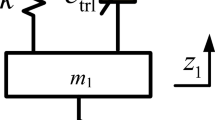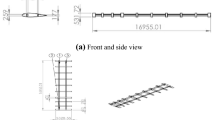Abstract
Many systems deal with the problem of undesired vibration transmitted to the occupant through the seat. It is an important issue related to the health and comfort of the occupant. In helicopters, it is a crucial problem regarding exposure of helicopter pilots to high vibration level. The seat as the main interface part plays a key role in order to reduce the vibration transmitted to the occupant body. Therefore, evaluation of the effect of the seat and its auxiliary equipment on the vibration reduction transmitted to the occupant is necessary. In this paper, a comprehensive evaluation is done concerning on the impact of the seat accessories (such as the suspension system and cushion) and attached equipment onto the helmet (such as the Night Vision Goggle and helmet-mounted display systems) on the vibration transmitted to the pilot’s body parts, especially the head, in order to determine contribution of seat design parameters in the vibration transmissibility reduction. Evaluations are performed based on ISO-2631 and conventional criteria using two distinctive model of occupant’s body. In addition, a beneficial mathematical relation is derived between the SEAT value and cushion characteristics. Accordingly, the characteristics of optimal cushion and the optimal seat suspension are derived from the results of the evaluations. Also in a scarce study, the impact of the seat parameters and attached equipment onto helmet on the neck stretch of pilot are evaluated under flight situation. In order to reach realistic results, the simulations are performed based on the measured vibration data of a Bell-412 helicopter. The results reveal that the optimal cushion and seat suspension system can decrease pilot vibration level up to 20% individually, but utilizing both of them together has not significant impact on more reduction of the vibration transmissibility.

Adapted from ISO 2631-1 [41]

















Similar content being viewed by others
Notes
Generally in standards, human body model do not mentioned but models may be presented based on requirements of any standards that have fairly good compatibility with them.
References
Wickramasinghe, V.: Dynamics Control Approaches to Improve Vibratory Environment of the Helicopter Aircrew. PhD Thesis, Carleton University, Canada (2013)
Chen, Y., Wickramasinghe, V., Zimcik, D.: Development of adaptive seat mounts for helicopter aircrew body vibration reduction. J. Vib. Control. 15, 1809–1825 (2009)
Chen, Y., Wickramasinghe, V., Zimcik, D.: Development of adaptive helicopter seat for aircrew vibration reduction. J. Intell. Mater. Syst. Struct. 22, 489–502 (2011)
Adam, J.: Results of NVG-Induced Neck Strain Questionnaire Study in CH-146 Griffon Aircrew. Defence Research and Development Toronto, Canada (2004)
Van den Oord, M.: Prevention of Flight-Related Neck Pain in Military Aircrew. PhD Thesis, University of Amsterdam, Netherlands (2012)
Thomae, M., Porteous, J., Brock, J.: Back pain in Australian military helicopter pilots: a preliminary study. J. Aviat. Sp. Environ. Med. 69, 468–473 (1998)
Shanahan, D.F., Reading, T.E.: Helicopter pilot back pain: a preliminary study. J. Aviat. Sp. Environ. Med. 55, 117–121 (1984)
Chen, Y., Wickramasinghe, V., Zimcik, D.: Investigation of helicopter seat structural dynamics for aircrew vibration mitigation. J. Am. Hel. Soc. 56, 12006–12006 (2011)
Grabau, P.J.: The Simulation of Vibrations Experienced by Patients During Helicopter Winching and Retrieval. PhD Thesis, James Cook University, Australia (2016)
Poje, A., Grigolato, S., Potočnik, I.: Operator exposure to noise and whole-body vibration in a fully mechanised CTL forest harvesting system in karst terrain. Croat. J. For. Eng. 40(1), 139–150 (2019)
Abouel-seoud, S.A.H.: Control of driver whole-body vibration ride comfort in agricultural tractor. Agric. Eng. Int. CIGR J. 21(2), 40–51 (2019)
Valentini, P.P., Pennestrì, E.: An improved three-dimensional multibody model of the human spine for vibrational investigations. Multibody Sys.Dyn. 36(4), 363–375 (2016)
Maradei, M.F., Quintana, L., Castellanos-Olarte, J.M.: Assessment of biomechanical demands and discomfort in drivers to stablish design criteria for truck seats. Int. J. Interact Des Manuf. 10(4), 431–437 (2016)
Chumchan, C., Tontiwattanakul, K.: Health risk and ride comfort assessment by ISO 2631 of an ambulance. In: 5th International Conference on Engineering, Applied Sciences and Technology (ICEAST), Luang Prabang, Laus. 2nd–5th July 2019, pp. 1–4 (2019)
Ittianuwat, R., Fard, M., Kato, K.: The transmission of vibration at various locations on vehicle seat to seated occupant body. INTER-NOISE and NOISE-CON Cong. Conf. Proc. 249(6), 2062–2073 (2014)
Zhang, X., Qiu, Y., Griffin, M.J.: Developing a simplified finite element model of a car seat with occupant for predicting vibration transmissibility in the vertical direction. Ergon 58(7), 1220–1231 (2015)
Grujicic, M., Pandurangan, B., Arakere, G., Bell, W.C., He, T., Xie, X.: Seat-cushion and soft-tissue material modeling and a finite element investigation of the seating comfort for passenger-vehicle occupants. Mater. Des. 30(10), 4273–4285 (2009)
Chen, Y., Wang, Y., Hua, H.X.: Performance of an elastic polymer foam cushion in attenuating responses of shipboard standing-men to ship vertical shock. J. Vib. Control 19, 1999–2012 (2013)
Kim, T.H., Kim, Y.T., Yoon, Y.S.: Development of a biomechanical model of the human body in a sitting posture with vibration transmissibility in the vertical direction. Int. J. Ind. Ergon. 35, 817–829 (2005)
Rosen, J., Arcan, M.: Modeling the human body/seat system in a vibration environment. J. Biomech. Eng. 125(2), 223–231 (2003)
May, P., Zhou, E., Lee, C.W.: Learning in fully recurrent neural networks by approaching tangent planes to constraint surfaces. Neural Netw. 34, 72–79 (2012)
Widrow, B., Greenblatt, A., Kim, Y., Park, D.: The No-Prop algorithm: anew learning algorithm for multilayer neural networks. Neural Netw. 37, 182–188 (2013)
Zadpoor, A.A., Campoli, G., Weinans, H.: Neural network prediction of load from the morphology of trabecular bone. Appl. Math. Model. 37(7), 5260–5276 (2013)
Mozaffarin, A., Pankoke, S., Wölfel, H.P.: MEMOSIK V—an active dummy for determining three-directional transfer functions of vehicle seats and vibration exposure ratings for the seated occupant. Int. J. Ind. Ergon. 38(5), 471–482 (2008)
Nagarkar, M.P., Patil, G.J.V., Patil, R.N.Z.: Optimization of nonlinear quarter car suspension–seat–driver model. J. Adv. Res. 7(6), 991–1007 (2016)
Stein, G.J., Múčka, P., Gunston, T.P., Badura, S.: Modelling and simulation of locomotive driver’s seat vertical suspension vibration isolation system. Int. J. Ind. Ergon. 38(5), 384–395 (2008)
Toward, M.G., Griffin, M.J.: The transmission of vertical vibration through seats: Influence of the characteristics of the human body. J. Sound Vib. 330(26), 6526–6543 (2011)
Blüthner, R., Hinz, B., Menzel, G., Schust, M., Seidel, H.: On the significance of body mass and vibration magnitude for acceleration transmission of vibration through seats with horizontal suspensions. J. Sound Vib. 298(3), 627–637 (2006)
Sun, X., Jing, X.: A nonlinear vibration isolator achieving high-static-low dynamic stiffness and tunable anti-resonance frequency band. Mech. Syst. Signal Process. 80, 166–188 (2016)
Davoodi, E., Safarpour, P., Pourgholi, M., Khazaee, M.: A nonlinear seat suspension with high-static low-dynamic stiffness based on negative stiffness structure for helicopter. J. Vib. Control 6, 66 (2021)
Carrella, A., Brennan, M., Waters, T.: On the design of a high-static–low-dynamic stiffness isolator using linear mechanical springs and magnets. J. Sound Vib. 315, 712–720 (2008)
Carrella, A., Brennan, M., Waters, T.J.: Demonstrator to show the effects of negative stiffness on the natural frequency of a simple oscillator. J. Mech. Eng. Sci. 222, 1189–1192 (2008)
Ji, X., Eger, T.R., Dickey, J.P.: Evaluation of the vibration attenuation properties of an air-inflated cushion with two different heavy machinery seats in multi-axis vibration environments including jolts. Appl. Ergon. 59, 293–301 (2017)
Duncan, O.: Auxetic Foams for Sports Applications. PhD Thesis, Sheffield Hallam University, England (2019)
Ilić, Z., Rašuo, B., Jovanović, M., Jovičić, S., Tomić, L., Janković, M., Petrašinović, D.: The efficiency of passive vibration damping on the pilot seat of piston propeller aircraft. Measurement 95, 21–32 (2017)
Maciejewski, I., Krzyzynski, T.: Method of selecting vibro-isolation properties of vibration reduction systems. J. Mech. Sci. Technol. 30(4), 1497–1505 (2016)
Beard, G.F., Griffin, M.J.: Discomfort of seated persons exposed to low frequency lateral and roll oscillation: effect of seat cushion. Appl. Ergon. 45(6), 1547–1557 (2014)
Blood, R.P., Ploger, J.D., Yost, M.G., Ching, R.P., Johnson, P.W.: Whole body vibration exposures in metropolitan bus drivers: a comparison of three seats. J. Sound Vib. 329(1), 109–120 (2010)
Zhang, X., Qiu, Y., Griffin, M.J.: Transmission of vertical vibration through a seat: effect of thickness of foam cushions at the seat pan and the backrest. Int. J. Ind. Ergon. 48, 36–45 (2015)
Ji, X.: Evaluation of Suspension Seats Under Multi-axis Vibration Excitations—A Neural Net Model Approach to Seat Selection. PhD Thesis, The University of Western Ontario, Canada (2015)
Griffin, M.J.: Handbook of Human Vibration. Academic Press, Cambridge (2012)
Rosenberger, A., Liphardt, A.M., Bargmann, A., Müller, K., Beck, L., Mester, J., Zange, J.: EMG and heart rate responses decline within 5 days of daily whole-body vibration training with squatting. PLoS ONE 9(6), 66 (2014)
Newell, G.S., Mansfield, N.J.: Evaluation of reaction time performance and subjective workload during whole-body vibration exposure while seated in upright and twisted postures with and without armrests. Int. J. Ind. Ergon. 38, 499–508 (2008)
Rittweger, J., Beller, G., Felsenberg, D.: Acute physiological effects of exhaustive whole-body vibration exercise in man. Clin. Physiol. 20, 134–142 (2000)
Rebelle, J.: Methodology to improve the performance of the end-stop buffers of suspension seats. Veh. Syst. Dyn. 42(4), 211–233 (2004)
Arora, N., Grenier, S.G.: Acute effects of whole body vibration on directionality and reaction time latency of trunk muscles: the importance of rest and implications for spine stability. J. Electromyogr. Kinesiol. 23, 394–401 (2013)
Vibration, M.: Shock-Evaluation of Human Exposure to Whole-Body Vibration-Part 1: General Requirements. ISO Standard, 2631-1 (1997)
Ellis, B.R., Littler, J.D.: Response of cantilever grandstands to crowd loads. Part 1: serviceability evaluation. Proc. Inst. Civ. Eng. Struct. Build. 157(4), 235–241 (2004)
McMahon, T.W., Newman, D.G.: The differential effect of sustained operations on psychomotor skills of helicopter pilots. Aerosp. Med. Hum. Perform. 89(6), 496–502 (2018)
Knothe, K., Stichel, S.: Human perception of vibrations—ride comfort. In: Rail Vehicle Dynamics, pp. 141–157. Springer, Cham (2017)
Wu, J., Zhang, R.R., Wu, Q., Stevens, K.K.: Environmental vibration assessment and its applications in accelerated tests for medical devices. J. Sound. Vib. 267(2), 371–383 (2003)
Jang, R., Lee, M., Lee, H.: Study of neck injury evaluation and improvement method for US NCAP 5% dummy. In: 23rd International Technical Conference on the Enhanced Safety of Vehicles (ESV) National Highway Traffic Safety Administration, Seoul, Republic of Korea. 27th–30th May 2013, No. 13-0364 (2013)
Euro, N. C. A. P.: Technical Report. European New Car Assessment Program (Euro NCAP) Test Protocol-AEB VRU Systems (2017). http://www.cdn.euroncap.com/media/euro-ncap-aeb-vru-test-protocol-v301
Harrison, M.F., Coffey, B., Albert, W.J., Fischer, S.L.: Night vision goggle-induced neck pain in military helicopter aircrew: a literature review. Aviat. Space Environ. Med. 86(1), 46–55 (2015)
Phillips, A.S.: The Scope of Back Pain in Navy Helicopter Pilots. Master Thesis, Naval Postgraduate School, USA (2011)
Kieneke, R., Graf, C., Maas, J.: Active seat suspension with two degrees of freedom for military vehicles. IFAC Proc. Vol. 46(5), 523–529 (2013)
Zhao, X., Schindler, C.: Investigation of the effect of safety belt on the seat transmissibility. Proc. Inst. Mech. Eng. Part K J. Multi-body Dyn. 228(3), 252–265 (2014)
Nahvi, H., Fouladi, M.H., Nor, M.M.: Evaluation of whole-body vibration and ride comfort in a passenger car. Int. J. Acoust. Vib. 14(3), 143–149 (2009)
Harrison, M.F., Neary, J.P., Albert, W.J., Veillette, D.W., McKenzie, N.P., Croll, J.C.: Physiological effects of night vision goggle counterweights on neck musculature of military helicopter pilots. Mil. Med. 172(8), 864–870 (2007)
Night Vision Goggles/ Image Intensifier Set AN/AVS-9 (F4949 Series). Retrieved 14 March 2009. http://www.nightvision.com/products/military/productpages/datasheet/anavs-9_f4949series.pdf
Bayer, M.M., Rash, C.E., Brindle, J.H.: Introduction to helmet-mounted displays. In: Melzer, J.E., et al. Helmet-mounted displays: sensation, perception, and cognition issues, pp. 47–108. Fort Rucker: US Army Aeromedical Research Laboratory (2009)
Author information
Authors and Affiliations
Corresponding author
Additional information
Publisher's Note
Springer Nature remains neutral with regard to jurisdictional claims in published maps and institutional affiliations.
Rights and permissions
About this article
Cite this article
Davoodi, E., Safarpour, P., Pourgholi, M. et al. Evaluation of the vibration transmitted to pilot’s body parts to determine the contribution of different design parameters in deficiency of available seats. Int J Interact Des Manuf 16, 339–357 (2022). https://doi.org/10.1007/s12008-021-00829-2
Received:
Accepted:
Published:
Issue Date:
DOI: https://doi.org/10.1007/s12008-021-00829-2




